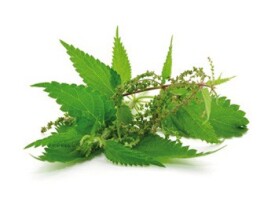Brief description
Stinging nettle is a perennial plant that is very hardy. There is probably no one who does not know the saying: frost will not burn nettles. It is widespread throughout the world, mainly in the northern hemisphere, but can also be found in the tropics. Nettles can grow up to 1.5 metres high. It is nourished by creeping rhizomes that are yellow to orange. The stem, the stalk, is straight. In young plants it is not branched, in older ones it branches at the top of the plant. The stem is hairy, as are the leaves, which have a typical saw-toothed edge. Both stem and leaves are glabrous. The trichomes of the leaves and stem are responsible for the stinging with acetylcholine, histamine, serotonin, leukotrienes and formic acid. Nettle has unisexual flowers, i.e. separate male and female flowers, both types of flowers forming an inflorescence. The females are latent and the males are racemose. After flowering, an ovoid achenes are produced. For most of us nettles are just an unpleasant stinging weed, but many people eat nettles fresh, e.g. instead of spinach, but dried leaves and stems are more commonly used.
Composition of nettles:
Nettles contain a large number of biologically active substances, among the best known are:
Essential oils:
- Camphor
- Carvacrol
- Naphthalene
- Safranal
- Borneol
- Decanal
- Menthol
- Thymol
- Beta-Cyclocitral
- Farnesol
- Gamma-Kadinen
- Hexenal
- Etc.
Other:
EU approved health claims:
It is already clear from the short list of ingredients that nettle contains that its effects will be diverse. We will only list those that are among the approved health claims. However, this is far from all that nettle can help with.
Thanks to nettle, you can maintain:
- Normal functioning of the vascular system
- Normal cardiovascular function
- Normal bones, hair and nails
- Normal kidney function - excretion
- Normal condition of joints
- Normal state of the respiratory system
- Normal skin condition
- Normal prostate function
It is also suitable for:
- Natural immunity - immune system
- Refreshment of the body
- Vitality - energy
- Heavy legs
- Excretion of water from the body
We would like to inform you that our website can no longer make claims that are not EU approved health claims and could give the impression of any medicinal effect of herbs or mushrooms. Current EU legislation prohibits this. This is despite the fact that traditional Chinese medicine has worked for thousands of years and has been tested on countless patients. At the same time, we must not mention the effects proven by contemporary scientific studies. But we believe in the common sense of our customers. For detailed information about herbs and mushrooms, please search the publicly available sources on the Internet. For example, valuable information can be found at www.tcmencyklopedie.cz.
Sources of information on vital mushrooms:
Martin Powell - Medicinal Mushrooms A Clinical Guide
Pavel Valíček - Mushrooms and their medicinal effects
G.M. Halpren, A.H. Miller - Medicinal Mushrooms Ancient Remedies dor Modern Ailments
G.M. Halpren - Healing Mushrooms
Christopher Hobbs - Medicinal Mushrooms An Ecploration of Tradition, Healing and Culture
Robert Rogers - The Fungal Pharmacy
Vladimir Ando - Pharmacology of Classical Chinese Medicine
Radomir Soch, Alexandr Jegorov - Encyclopedia of Medicinal Mushrooms
Bensky - Materia Medica
 Medicinal mushrooms PRO (17)
Medicinal mushrooms PRO (17) MyTao Edition (14)
MyTao Edition (14) Medicinal mushroom Extracts (25)
Medicinal mushroom Extracts (25) Combination of mushrooms and herbs (18)
Combination of mushrooms and herbs (18) Traditional recipes (5)
Traditional recipes (5) BIO medicinal mushrooms powder (9)
BIO medicinal mushrooms powder (9) Syrups (12)
Syrups (12) Dried medicinal mushrooms (7)
Dried medicinal mushrooms (7) Honey products (5)
Honey products (5) Vitamins (4)
Vitamins (4) BIO green food (2)
BIO green food (2) Other (1)
Other (1)
